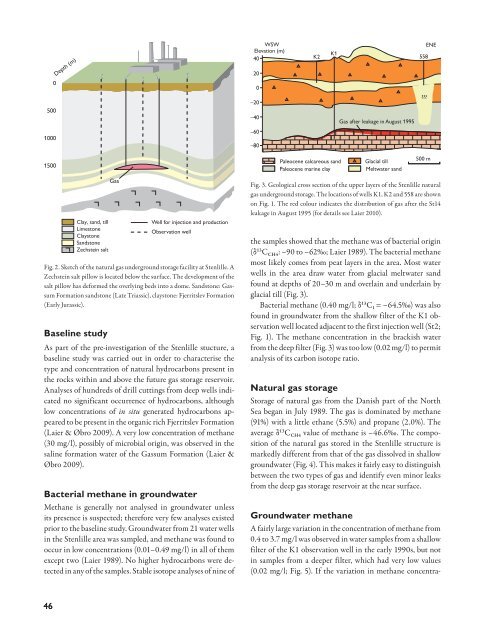Geological Survey of Denmark and Greenland Bulletin 26 ... - Geus
Geological Survey of Denmark and Greenland Bulletin 26 ... - Geus
Geological Survey of Denmark and Greenland Bulletin 26 ... - Geus
You also want an ePaper? Increase the reach of your titles
YUMPU automatically turns print PDFs into web optimized ePapers that Google loves.
0<br />
500<br />
Depth (m)<br />
WSW<br />
Elevation (m)<br />
40<br />
20<br />
0<br />
–20<br />
–40<br />
K2<br />
K1<br />
Gas after leakage in August 1995<br />
558<br />
???<br />
? ?<br />
ENE<br />
1000<br />
–60<br />
–80<br />
1500<br />
Paleocene calcareous s<strong>and</strong><br />
Paleocene marine clay<br />
Glacial till<br />
Meltwater s<strong>and</strong><br />
500 m<br />
Clay, s<strong>and</strong>, till<br />
Limestone<br />
Claystone<br />
S<strong>and</strong>stone<br />
Zechstein salt<br />
Baseline study<br />
Gas<br />
Well for injection <strong>and</strong> production<br />
Observation well<br />
Fig. 2. Sketch <strong>of</strong> the natural gas underground storage facility at Stenlille. A<br />
Zechstein salt pillow is located below the surface. The development <strong>of</strong> the<br />
salt pillow has deformed the overlying beds into a dome. S<strong>and</strong>stone: Gassum<br />
Formation s<strong>and</strong>stone (Late Triassic), claystone: Fjerritslev Formation<br />
(Early Jurassic).<br />
As part <strong>of</strong> the pre-investigation <strong>of</strong> the Stenlille stucture, a<br />
baseline study was carried out in order to characterise the<br />
type <strong>and</strong> concentration <strong>of</strong> natural hydrocarbons present in<br />
the rocks within <strong>and</strong> above the future gas storage reservoir.<br />
Analyses <strong>of</strong> hundreds <strong>of</strong> drill cuttings from deep wells indicated<br />
no significant occurrence <strong>of</strong> hydrocarbons, although<br />
low concentrations <strong>of</strong> in situ generated hydrocarbons appeared<br />
to be present in the organic rich Fjerritslev Formation<br />
(Laier & Øbro 2009). A very low concentration <strong>of</strong> methane<br />
(30 mg/l), possibly <strong>of</strong> microbial origin, was observed in the<br />
saline formation water <strong>of</strong> the Gassum Formation (Laier &<br />
Øbro 2009).<br />
Bacterial methane in groundwater<br />
Methane is generally not analysed in groundwater unless<br />
its presence is suspected; therefore very few analyses existed<br />
prior to the baseline study. Groundwater from 21 water wells<br />
in the Stenlille area was sampled, <strong>and</strong> methane was found to<br />
occur in low concentrations (0.01–0.49 mg/l) in all <strong>of</strong> them<br />
except two (Laier 1989). No higher hydrocarbons were detected<br />
in any <strong>of</strong> the samples. Stable isotope analyses <strong>of</strong> nine <strong>of</strong><br />
Fig. 3. <strong>Geological</strong> cross section <strong>of</strong> the upper layers <strong>of</strong> the Stenlille natural<br />
gas underground storage. The locations <strong>of</strong> wells K1, K2 <strong>and</strong> 558 are shown<br />
on Fig. 1. The red colour indicates the distribution <strong>of</strong> gas after the St14<br />
leakage in August 1995 (for details see Laier 2010).<br />
the samples showed that the methane was <strong>of</strong> bacterial origin<br />
(δ 13 C CH4 : –90 to –62‰; Laier 1989). The bacterial methane<br />
most likely comes from peat layers in the area. Most water<br />
wells in the area draw water from glacial meltwater s<strong>and</strong><br />
found at depths <strong>of</strong> 20–30 m <strong>and</strong> overlain <strong>and</strong> underlain by<br />
glacial till (Fig. 3).<br />
Bacterial methane (0.40 mg/l; δ 13 C 1 = –64.5‰) was also<br />
found in groundwater from the shallow filter <strong>of</strong> the K1 observation<br />
well located adjacent to the first injection well (St2;<br />
Fig. 1). The methane concentration in the brackish water<br />
from the deep filter (Fig. 3) was too low (0.02 mg/l) to permit<br />
analysis <strong>of</strong> its carbon isotope ratio.<br />
Natural gas storage<br />
Storage <strong>of</strong> natural gas from the Danish part <strong>of</strong> the North<br />
Sea began in July 1989. The gas is dominated by methane<br />
(91%) with a little ethane (5.5%) <strong>and</strong> propane (2.0%). The<br />
average δ 13 C CH4 value <strong>of</strong> methane is –46.6‰. The composition<br />
<strong>of</strong> the natural gas stored in the Stenlille structure is<br />
markedly different from that <strong>of</strong> the gas dissolved in shallow<br />
groundwater (Fig. 4). This makes it fairly easy to distinguish<br />
between the two types <strong>of</strong> gas <strong>and</strong> identify even minor leaks<br />
from the deep gas storage reservoir at the near surface.<br />
Groundwater methane<br />
A fairly large variation in the concentration <strong>of</strong> methane from<br />
0.4 to 3.7 mg/l was observed in water samples from a shallow<br />
filter <strong>of</strong> the K1 observation well in the early 1990s, but not<br />
in samples from a deeper filter, which had very low values<br />
(0.02 mg/l; Fig. 5). If the variation in methane concentra-<br />
46

















